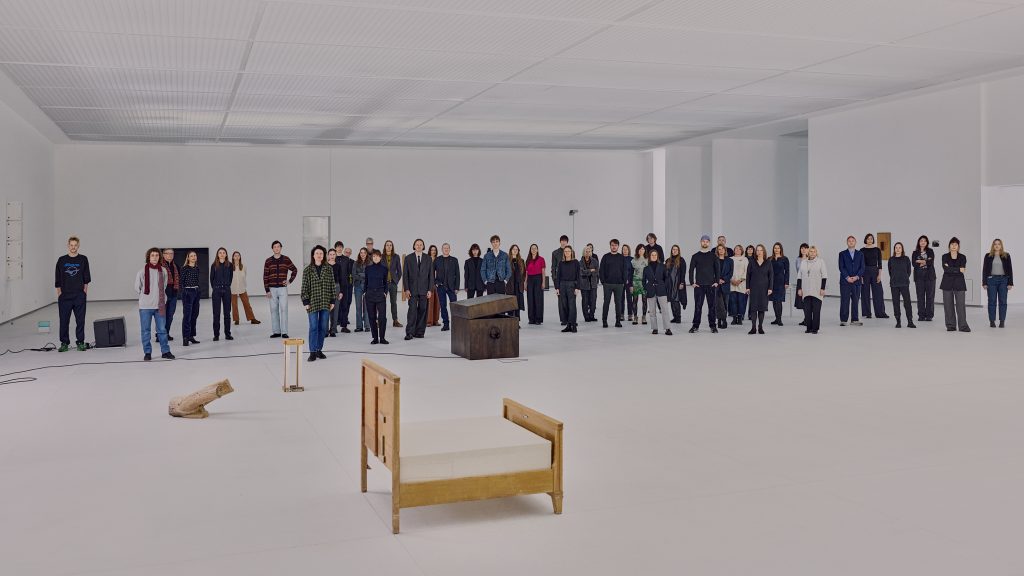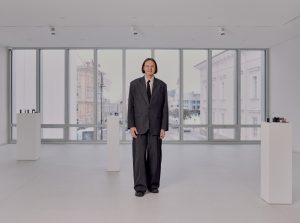
The definition of vision is inherently tied to the future and speculation. This particular vision was conceived before work began, without access to essential data – before properly inspecting the buildings, understanding the financial, technical, or human resources in detail, or fully engaging with the large and experienced team. In short, before encountering reality. The five-year vision of the CAC also had to be submitted as part of the application for the director’s position – a five-year plan in a world where the future, even a month away, remains completely opaque. Therefore, this concise version of my vision is not a fixed blueprint carved into the building’s façade but a value-driven hypothesis. Its reliability will be tested in practice, and I hope we will adapt it together as reality, and we ourselves, continue to evolve.
One of the key inspirations for this vision is the design of the Exhibition Palace (1967), now the CAC, by architect Vytautas Edmundas Čekanauskas. The building was founded on the principle of transparency: the entrance and lobby were deliberately designed to be open and smaller in scale, allowing All Saints’ Church to remain visible from Town Hall Square. This design aimed to create a dialogue between the now UNESCO-protected Vilnius Old Town and the comparatively brutal modernist structure inserted into it. Additionally, the entrance and staircase areas were intended to be visible from different sides of the building. After reopening last year following major renovations, the CAC restored the outdoor staircase’s transparency and introduced the motif of glass walls – an element that diverges from Čekanauskas’s original design. Building on this legacy, my vision is for the CAC to embody openness and transparency, not only as a building but also as an institution.
In this context, I understand openness in several senses. One of the most important tasks of the CAC should be turning towards its visitors – both art professionals, including artists, and the general public. I believe that the role of the new CAC Director entails establishing a new relationship with both existing and potential visitors. With this in mind, I hope to see the CAC and its spaces – its exhibitions, performances, lectures, Cinema Hall, Sapieha Palace, Reading Room, educational workshops, Sculpture Yard, and café – frequented by large audiences. My hope is for the modernist CAC at the heart of the city, alongside the historic Sapieha Palace, to serve not only as venues for artistic experimentation but also as hubs for discussions on relevant issues and meeting places for various communities. This includes enhancing the visitor experience – ensuring a welcoming staff, providing clear and accessible information, and further improving the interior spaces with comfortable design, appropriate lighting, age-friendly furniture, and informative displays. I believe visitors, through their participation and presence in the CAC, play a pivotal role in shaping the art scene, sometimes influencing the works and exhibitions, and ultimately transforming the institution itself. Generosity – in intellectual, informational, emotional, and emphatic forms – should be the guiding principle of the CAC’s operations.
New advisory boards and, more broadly, greater inclusion of advisory voices in the CAC’s activities would further expand the meaning of openness and transparency. Recommendations, advice, and constructive criticism could provide valuable support to the institution in matters of communication, partnerships, development, work ethics, fair remuneration for artists and cultural workers, and the selection process for curators of the Baltic Triennial, among other issues.
Advice and counselling will certainly be needed in the present reality. The questions that the CAC must address are numerous and complex. For instance: What is modernity, and what does it mean today? What are the functions of contemporary art and the institutions that represent it in this era of multiple crises? How have these functions evolved since the founding of the CAC? How has our society changed, and what is the CAC’s role in the thriving Lithuanian contemporary art ecosystem? In this increasingly polarised world, what kind of artistic or other types of reality are we addressing? Can we still trust and believe in contemporary art? Finally, what does the art institution of the future look like, when the future itself feels ever more uncertain and dark?
Let us pause to consider that complex and often elusive reality. In an era marked by multiple global crises, the rise of military conflicts, disinformation, political populism, and authoritarian rule, human rights are being violated, and the climate crisis continues to worsen: it is estimated that irreversible climate change and a major ecological catastrophe may be only five or fewer years away. Russia’s aggression has left the Baltic Sea region and Central and Eastern Europe profoundly unstable, with even greater challenges looming. In this intricate context, I envision the CAC as a significant artistic and intellectual hub for the region – one that actively contributes to shaping historical, social, and other forms of justice while fostering new visions for the future through its exhibitions, educational initiatives, and publishing activities. The CAC should strive to be a regional leader in contemporary art, responsibly balancing audience development, responsiveness to socio-political issues, and respect for the professional art field.
I would like to conclude with what I intended to begin with, before my thoughts carried me away: an expression of gratitude and respect. It is essential to honour this already historically significant institution, its former director, Kęstutis Kuizinas, its past and present staff, the artists who have exhibited here, the curators, and the visitors. Without you, the art scenes of Vilnius, Lithuania, the Baltic States, and Northern, Eastern, and Central Europe would look very different. It is both a great honour and a meaningful responsibility for me to have the opportunity to turn my modest visions into reality within this institution.
Finally, I want to emphasise a central idea: in these times of overwhelming change, generosity in all its forms – whether aesthetic, intellectual, informational, emotional, or empathic – must become the guiding principle of the renewed CAC. This transformation will not happen overnight; we will need your patience, your criticism, and your support.
Let us meet.

Valentinas Klimašauskas has been widely recognised as a contemporary art curator and writer.
Among the larger international projects he has curated are the Lithuanian National Pavilion at the Venice Biennale of Contemporary Art (in collaboration with João Laia, featuring artists Pakui Hardware and Marija Teresė Rožanskaitė, National Art Museum of Lithuania, 2024), Coast Contemporary Art Festival in Lofoten Islands, Norway (2023), 14th Baltic Triennial The Endless Frontier (with João Laia, CAC, Vilnius, 2021), Alexandra Pirici’s choreographic project (Kaunas Ninth Fort Monument to the victims of Nazism, 2020), and the Latvian National Pavilion at the Venice Biennale of Contemporary Art (with Inga Lāce, featuring Daiga Grantina’s solo exhibition Saules Suns, 2019).
In 2024, Klimašauskas published a book titled Telebodies: Bleeding Subtitles for Postrobotic Scenes (Mousse Publishing, Milan), as part of his PhD thesis at the Vilnius Academy of Arts. Klimašauskas is also the author of the fiction books Daugiakampis (Six Chairs Books, Kaunas, 2018), Oh, My Darling & Other Rants (The Baltic Notebooks of Anthony Blunt, Vilnius, 2018), and Alfavilnius (Kitos Knygos, Vilnius, 2008). He has contributed various texts to publications such as A Prior Magazine, As a Journal, Beyond, Cura, Dot Dot Dot, Flash Institut, Flash Art, Kim Docs, Kunsthernes Hus, Good Times & Nocturnal News, North Athens, CAC Interviews, Metropolis M, Mousse, Nero, Paletten, and Spike, among others.
Photos: Audrius Solominas